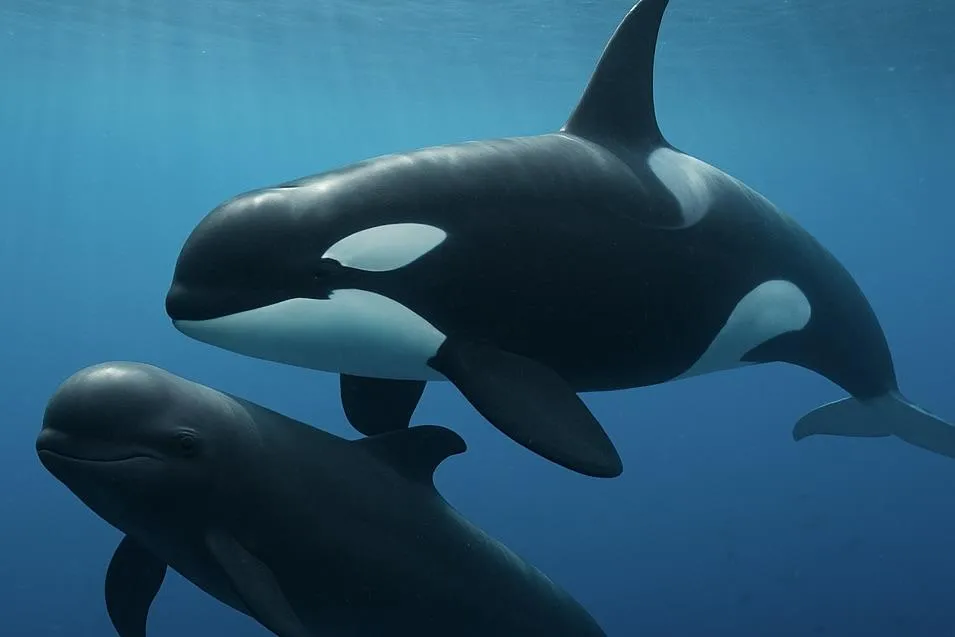
Borrowed Calf: A Puzzling Adoption of a Pilot Whale by Killer Whales
Most stories in science don't begin with answers—they start with confusion. This is certainly the case with the story of killer whales and pilot whales in the North Atlantic. At first glance, these two species have much in common: they are both large, intelligent, and social members of the oceanic dolphin family. They occupy similar physical spaces, sometimes eat the same food, and form tightly-knit family groups. But despite these similarities, their interactions are anything but predictable.
Sometimes, pilot whales chase killer whales in what seems to be a deliberate act of aggression. Research shows that even the sounds killer whales make when feeding stir pilot whales into giving chase. Other times, however, we see a killer whale swimming alongside a newborn pilot whale calf—not as a predator or aggressor, but seemingly as a caregiver. These observations defy easy explanations and open the door to a big, unanswered question: What exactly is happening between these two species?
Pilot Whale Aggression on Killer Whales
Many of our observations of pilot and killer whales involve antagonistic behavior from pilot whales toward killer whales. The very sound of killer whale foraging calls seems to rally the pilot whales into larger groups and attract them at high speeds. For some unexplained reason, pilot whales seem to really dislike killer whales.
The pilot whale's aggression isn't fully understood—it could be competition over resources, proactive aggression towards potential predators, or any other host of reasons. All we seem to understand is that pilot whales do not like killer whales.
Killer Whale Caretaking of Pilot Whales
But killer whales didn't seem to get the memo! Since 2021, researchers have observed female killer whales in apparent caretaking relationships with neonate (or newborn) pilot whales. The pilot whales in these observations are far too young to be left alone, and the female killer whale in at least one of the situations had never had a calf of her own. Unfortunately, the observations never included how the killer whale came to be with the pilot whale, nor how the relationship ended.
Why might this happen, though? There are two potential reasons:
Practicing caretaking skills for the female killer whale. In one of the observations, the killer whale was a well-known individual who had never had a calf before. Her interactions with the pilot whale calf were indicative of caretaking, and may have been a 'practice scenario' for when she had her own calves.
Practice hunting behaviors. One of the observations showed killer whale behavior that may be consistent with practicing hunting behaviors—specifically practice herding fish by using a small dolphin. In one observation, a killer whale came on each side of the pilot whale and was directing its swimming. They also seemed to allow it to partially get away before surrounding it again. However, while these behaviors may indicate practice hunting, it is not definitive.
How Does it End?
Unfortunately, regardless of the intention of the killer whales, these interactions don't seem to end well for the pilot whale calves. Many of the photos from the observations show the calf as highly emaciated, and the pairing of a killer whale and pilot whale calf are never seen for more than a day. This unfortunate end may be the result of practice hunting—which frequently has a fatal outcome for the practice target—but it may also just be an inability of the killer whale to nurse the pilot whale despite its best caretaking effort. Either way, these interactions appear to be fatal for the pilot whale calves.
Is this the reason for the antagonistic interactions between pilot whales and killer whales? We aren't really sure yet. It may be this, but it may also be any other reason. Just like most stories in science, we are in the beginning stages where we have much more confusion and questions right now than we have answers.
References
Baumgartner, C. D., Selbmann, A., Middel, H., Schulze, J., Bellon, G., & Samarra, F. I. P. (2025). Interactions Between Killer Whales (Orcinus orca) and Neonate Long-Finned Pilot Whales (Globicephala melas) off South Iceland. Ecology and Evolution, 15(4), e71193. https://doi.org/10.1002/ece3.71193
Curé, C., Antunes, R., Samarra, F., Alves, A. C., Visser, F., Kvadsheim, P. H., & Miller, P. J. O. (2012). Pilot Whales Attracted to Killer Whale Sounds: Acoustically-Mediated Interspecific Interactions in Cetaceans. PLOS ONE, 7(12), e52201. https://doi.org/10.1371/journal.pone.0052201
Mrusczok, M.-T., Zwamborn, E., von Schmalensee, M., Ramallo, S. R., & Stefansson, R. A. (2023). First account of apparent alloparental care of a long-finned pilot whale calf (Globicephala melas) by a female killer whale (Orcinus orca). Canadian Journal of Zoology, 101(4), 288–293. https://doi.org/10.1139/cjz-2022-0161
Selbmann, A., Basran, C. J., Bertulli, C. G., Hudson, T., Mrusczok, M.-T., Rasmussen, M. H., Rempel, J. N., Scott, J., Svavarsson, J., Wensveen, P. J., Whittaker, M., & Samarra, F. I. P. (2022). Occurrence of long-finned pilot whales (Globicephala melas) and killer whales (Orcinus orca) in Icelandic coastal waters and their interspecific interactions. Acta Ethologica, 25(3), 141–154. https://doi.org/10.1007/s10211-022-00394-1
